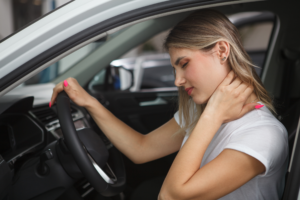The first car was invented in 1885.
139 years on, there are approximately over 1.4 billion licensed drivers in the world. In developed countries, approximately 50% of the drivers are women, and in developing countries, approximately 15%.
65 million cars are sold every year.
Big numbers? Sure, but let’s look closer to home. How many women in your family, neighbourhood, or workplace drive cars every day? Those are the numbers we’re talking about here.
When it comes to car safety, the “standard” is the default male. They’re all built with one body type in mind: a 5’9”, 171-pound man.
Seatbelts? Airbags? Crash-test dummies? All designed, built, and tested on the default standard. So, if you’re a woman—or just someone who doesn’t fit that mould—your car is, unbeknownst to you, working against you. And when it comes to crashes, the stakes couldn’t be higher.
The Problem: Designed to Fail Women, Unintentionally

Let’s start with the cold, hard facts. Women are:
47% more likely to be seriously injured in car crashes.
17% more likely to die in those same crashes.
And this isn’t just about being shorter, lighter, or differently built. Even when controlling for weight, height, and seatbelt use, the risks remain. Why?
1. Crash-Test Dummies: The industry’s “female dummy” is often just a scaled-down male model, ignoring key differences in female anatomy like breast tissue, smaller rib cages, and higher fat distribution.
2. Seatbelts: Women’s shorter torsos and unique body shapes make them more prone to chest, neck, and abdominal injuries.
3. Pregnancy: With 62% of third-trimester women unable to fit seatbelts properly, moms-to-be are left vulnerable—and so are their unborn babies.
It’s like designing a helmet for a watermelon and expecting it to fit a cantaloupe. The math doesn’t add up, and the results can be catastrophic.
Let’s imagine the Absurdity
Picture this: You’re buying a house, and every doorframe is suitable for heights 4’5” and lower only. If you’re taller, well, tough luck. Or imagine all the gloves in the world being designed only for people with 6 fingers. It’s laughable, right? But that’s exactly what car safety does: creates “solutions” for one section of the population and hopes the rest will just adapt.
Except when it comes to car crashes, there’s no adapting—only consequences. And they’re quite deadly.
But A Few Game-Changers Are Stepping Up

Each year, over 200 companies manufacture 65 million cars worldwide. Let’s throw light on the three that are doing it right because not all car manufacturers are stuck in the Stone Age. Some are proving that safety can (and should) be inclusive. Here’s who’s leading the charge:
Volvo has always been a leader in car safety, but they’re also leading in equity. Their E.V.A. Initiative uses decades of crash-test data from women and other underrepresented groups to redesign safety systems. They’ve even created a pregnant crash-test dummy to study the unique risks faced by expectant mothers.
Volvo’s motto? Safety for all. And looks like they mean it.
Toyota: Data-Driven Innovation
Toyota is gathering gender-specific crash data to build safer cars for everyone. By analyzing how different bodies react in crashes, they’re setting new standards for what “safe” truly means.
Mercedes-Benz: Tailoring Seatbelts
Mercedes-Benz has developed seatbelts that account for various body types, acknowledging that one-size-fits-all solutions don’t actually fit all. Surprising.
These companies aren’t just creating better cars; they’re creating better futures, safer futures. They’re proving that safety isn’t a compromise—it’s a commitment.
Car Models That Are Safe For Women
BMW 3-Series & 4-Series (Ages 31-50)
Chrysler 300 (Ages 31-50)
Hyundai Sonata (Ages 16-22)
Lexus IS
Mercedes C Class
Nissan Maxima
Subaru Legacy
Volkswagen Passat (Models 2018-2019)
Why Should You Care?
You might think, ‘I’ve never been in a crash, so why should I care?’ Well, that’s the point—you haven’t, and we hope you never do. But you still buy medical and car insurance every year just in case you do. For countless others who have, the consequences have been severe, all because safety designs prioritized one half of the population over the other. Isn’t it time we fixed that?
Safer designs benefit everyone. Inclusive safety standards mean fewer injuries, fewer fatalities, and fewer families torn apart.
If you have daughters, sisters, or friends who are women—don’t they deserve the same level of protection as everyone else? When half the population is excluded from safety standards, it’s not just oversight; it’s a stark reflection of misplaced priorities.

What We’re Saying
We believe that safety isn’t a privilege and never should be; it’s a right. The gender gap in car safety isn’t just a statistic—it’s a call to action. Because every time we settle for “good enough,” we’re failing the people we care about most.
So here’s our challenge to you:
The next time you’re car shopping, ask the question: “How many collision tests, that were done by the manufacturer, included women?” If the answer doesn’t satisfy you, hold automakers accountable. Your voice is your power. And when we all speak up, our voices as a collective can be the change maker. As is, the power of where you put your money.
Because equality on the road isn’t a luxury—it’s a necessity. And change? It starts with all of us.
Take the Wheel
We’re not here to just highlight the problem; we’re here to celebrate the progress and push for more. Share this article. Start the conversation. And together, let’s drive toward a future where everybody, no matter the gender, is protected equally.
Let’s get closer to the road we all deserve.
#WeMen #RoadToEquality #InclusiveSafety #VolvoSafety #ToyotaInnovation #MercedesBenzSafety #InclusiveCarDesign






